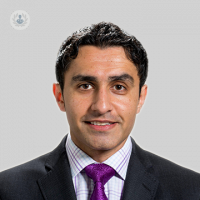What is glue ear and how is it treated?
Written in association with:Glue ear is a common condition that affects 80% of children at some point in their life. It’s easy to diagnose and can be treated, but it’s important to recognise it early on, since any hearing impairment can affect the development of your child. For this article we’ve interviewed Mr Ravinder Natt, consultant ENT surgeon based in London, to learn about the symptoms of glue ear, and how it is treated

What is glue ear?
Glue ear is a condition that commonly affects our ears. We predominantly see it in children, but we can also see it in adults.
When we've tried to pop our ears by closing our nose, we force air through the Eustachian tube and our eardrum pops. In a situation where a patient develops glue ear, the ability of this eustachian tube to work effectively is slightly affected, and eustachian tube becomes blocked. As a result, instead of air, we have fluid building up behind the eardrum. The fluid that starts to accumulate behind here is rather thick in appearance.
The reason glue ear is common in children is that the hearing apparatus is slightly immature. As we become adults, we’re able to manage this more effectively. However, as I suggested earlier, this can be seen in adults too.
What are the symptoms of glue ear?
The symptoms of glue ear predominantly are of hearing loss . Because of the fluid that builds up behind the eardrum, where there should be air, less air is conducted through and the patient will complain of hearing loss.
This is extremely important in children, particularly the early stages of life, where speech development is important. Any impairment of hearing will affect their speech development and overall development.
Other symptoms of glue ear could be pressure and pain.
Finally, you may have seen or taken your child to your GP with a condition known as otitis media. This involves fluid that predominately builds up behind the drum causing the drum to burst and release discharge. This is another feature of dysfunction of our middle ear apparatus, but it can be treated very effectively.
How is glue ear treated?
We treat glue ear in children and adults in the same way. The patient will have a hearing test performed first. This includes an audiogram to measure the hearing level, and a test known as a tympanogram, which measures the pressure behind the eardrum. In a patient with glue ear, there will be fluid there and no air behind the drum.
Based on these tests we'll then consider inserting under a short general anaesthetic a tube which is effectively a ventilation tube known as a grommet. The tube allows air to pass in for hearing and also allows fluid to dissipate out from the eardrum and keeps it dry.
The tube is then inserted into one aspect of the eardrum and it stays there for up to 12 to 18 months. We'll then repeat a hearing test to make sure all fluid and glue has disappeared and that the hearing has returned to the satisfactory levels.
If you have any worries about your child’s hearing, book a consultation with Mr Ravinder Natt today.


